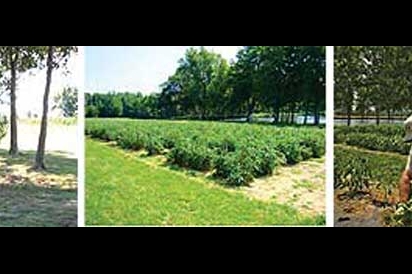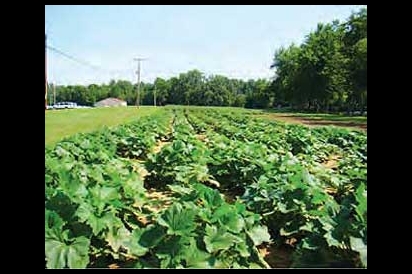From Cell To Celery
Prisoners grow food, skills, esteem in jail garden
The 380 inmates in the Hopkins County jail have committed or are awaiting trial for a wide range of crimes — “from nonpayment of fines to murder,” says jailer Joe Blue. But thanks to the jail’s unusual rural setting, and a jailer determined to make the most of it, those prisoners have a chance to spend some of their time learning gardening skills that could serve them well once they get back outside.
Hopkins has located its jail not downtown in the county seat, Madisonville, but outside it on about 40 open acres that include a pond, a stand of trees and outbuildings. “Across the street from the jail there’s a cornfield,” says Blue. “I can throw a rock from my window and hit a cornstalk.”
It’s a setting that gives Blue more opportunities than his counterparts whose jails are oftentimes confined to urban settings. He believes in using all that space to offer the inmates a chance to learn new skills. “We’ve had some that can’t even run a Weed Eater,” he says.
So starting a garden for the inmates seemed a natural step to help inmates build skill sets.
Blue started the garden after he was appointed jailer in 2005. In 22 years with Hopkins County law enforcement, he has now seen three generations cycle through the jail using their life skills to peddle controlled substances. The last study of inmates showed the average reading level at sixth grade. Blue’s goal is to make sure “they leave Hopkins County with more than when they came in.”
The 1¾-acre garden is one of several learning opportunities (along with a machine shop, car wash, road crew, construction teams). By the time they leave, he says, “they may not have a college education but they have a skill.”
Those skills, simple as they are, can translate to real money for inmates when they get out. Hopkins County horticulture agent Andy Rideout taught Master Gardener classes to eight inmates and three staff members, including garden manager and deputy jailer Jamey Harris. One of the inmates, released before completing the gardening course, was employed on a golf course and received a pay raise when he finished up.
Gardening (and welding, road work, and other tasks) also allows prisoners to work down their sentences. About 60% of inmates are transferred to Hopkins County from state facilities, saving money for the state. For every 40 hours they work, they reduce their sentence by a day. County inmates have a sweeter deal. For every hour they work they earn an hour of early freedom. Planting, weeding, harvesting and repairing or fabricating equipment all count toward early release.
Hopkins County is just one of several Kentucky counties that have introduced gardening to the inmate population.
Woodford and Jessamine jails both have gardens. Harlan County inmates harvested 24 tons of potatoes from their garden in 2011, saving taxpayers $9,000 on potatoes alone, and more than 2,100 gallons of beans, according to the website (www. harlandc.com/garden_report.html).
In 2009, the Ashland Daily Independent reported that the Greenup County jail “garden program has saved the county lockup about $50,000 by keeping the number of county inmates down (through work release), giving the jail room to house state prisoners, for which it receives $33 a day. Within a month after it was started, the program increased the number of state prisoners at the detention center from 12 to 27.”
Economics was a strong impetus for Blue to start his garden. “I’ve seen what food costs are and food costs never go down,” he says. He spends $500 to $600 per year on garden supplies and maintenance; in the past five years, the jail has saved more than $90,000 on fresh produce served throughout the 1,200 meals per day, and that’s fighting drought most years.
“We were lucky” in May 2006, says Blue. “It was a perfect year for gardening.” Since then, they have been plagued by lack of rain and 2012 is no different. With profits from the commissary, jail officials have purchased equipment that lays irrigation drip tape at the same time that inmates plant the crops. A newly installed water line hooked to the irrigation system makes it easy to water the plants regularly.
The jail’s menus are plain and straightforward. Chicken patties, hot dogs and spaghetti are regulars and the meals must provide 2,400 calories. A typical breakfast is “oatmeal, breakfast cake, fruit and milk,” always delivered on trays to barracks-type rooms of 20 or so inmates. Dinner might be chicken patty, gravy, mashed potatoes, biscuit, “veg” and drink, with dessert indicated on every menu as two ounces of cake, though it may be pie or another sweet.
During the growing season, sliced tomatoes (nearly 22,000 pounds since 2006), cantaloupe or watermelon might be the fruit at breakfast. Squash (15,000 pounds) or corn (33,000 ears) and the occasional fried green tomato might be the vegetable. (French fries are the only deepfried food left at the jail, and the buildings and grounds are tobacco free).
Last year, Blue came to work bearing a recipe his mother gave him for zucchini crisp. Zucchini slices seasoned with lemon, apple spices and sugar, it’s a ringer for apple crisp. Blue made it himself first, serving it to his wife and four children. They liked it, so he thought the jail kitchen could use it to move extra zucchini — a familiar phenomenon to any gardener. “The inmates loved it,” he says.
Still, excess is a problem, zucchini and otherwise. Because the Hopkins County jail has little room for storing food, the garden grows more vegetables than the inmates can consume. Surplus goes to the Salvation Army and senior centers in the county.
At any one time, about 80 prisoners will be working outside the walls of the jail — welding or clearing road debris with chainsaws, building a farmers market or gardening, learning a skill as they earn earlier release.
“This is the Department of Corrections,” says Blue. “I can’t lock them up for months at a time and expect [them to do] something different” when they leave. Sarah Fritschner is the editor of Edible Louisville and coordinator of the Louisville Farm to Table project.
Zucchini Crisp
An unbelievable transformation of zucchini into a dessert very much resembling an apple crisp, to be served warm with vanilla ice cream or unsweetened whipped cream.
Ingredients
Filling
About 5 medium zucchini, to make 8 cups chopped
¾ cup lemon juice
¾ cup sugar or brown sugar
¼ cup butter
2 teaspoons ground cinnamon
1 teaspoon ground nutmeg (substitute pumpkin pie spice if desired)
Topping
1⅓ cups packed brown sugar
1 cup rolled oats
1 cup all-purpose flour
⅔ cup cold butter, cubed
Instructions
- Peel the zucchini. Slice them in half lengthwise. Scrape out and discard seeds. Cut the zucchini in thin slices that resemble an apple slice (sort of a crescent moon).
- Combine 8 cups sliced zucchini in a large saucepan with lemon juice, sugar, butter, spices and salt. Bring to a boil over medium high heat, stirring often. Remove from heat and pour into a greased 9- by 13-inch baking pan.
- Heat oven to 375°.
- For topping, combine brown sugar, oats and flour in a bowl; cut in butter until crumbly. Sprinkle over the zucchini mixture. Bake 45 to 50 minutes or until bubbly and the zucchini is tender. Serves 15.







